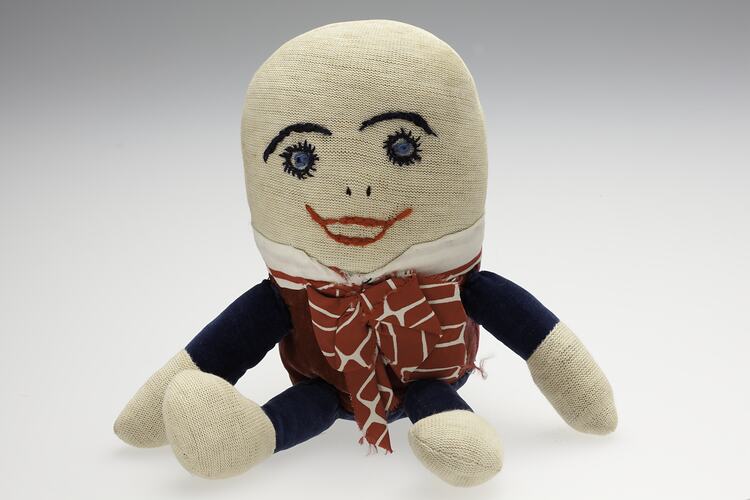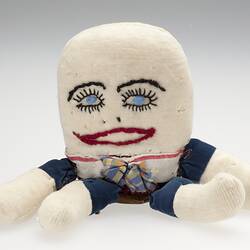Summary
Humpty Dumpty doll, from a collection of handcrafts, produced by English migrant Ada Perry, between the 1930s and 1960s.
Ada Perry migrated to Australia as a widow with eight children in 1924. She struggled to work a piece of isolated government allocated land at Mirboo North, until 1928 when a buggy accident left her unable to continue physical labour, so she created craft items, while her children worked the land.
The items in the Museum's collection are prototypes, as she kept the first of anything she created for her children and then gave away the rest. All Ada's handcrafts were made using available scraps or reusing old clothes, providing insight into a domestic environment where subsistence was a struggle and where 'making do' was a matter of course.
Physical Description
Oval shaped cream doll with arms and legs attached to the main body. The doll is dressed in dark blue shorts and jacket, a brown vest and wears a red and white tie. The eyes and mouth have been embroidered on using black, blue and red thread.
Significance
This collection provides a unique and valuable snapshot of one woman's domestic craft output in regional Victoria between the 1930s and 1960s. Ada Perry migrated to Australia from England as a widow with eight children in 1924. Viewing herself in the role of pioneer, she struggled to work a piece of isolated government allocated land at Mirboo North. A buggy accident in 1928 left her unable to continue physical labour and while her children worked to pay off the government loan and work the land, Ada worked with her hands. She had made and brought things out from England which have not survived, so this collection represents the type of handcrafts she produced during this 30 year period. They are prototypes, as she kept the first of anything she created for her children and then gave away the rest.
The quilts, toys and dolls are not particularly fine examples of handcrafts but they provide an evocative insight into a domestic environment where subsistence was a struggle, where 'making do' was a matter of course, and where a woman took much pride in creating gifts for family and neighbours. All of the items have been made using available scraps or reusing old clothes. As one of the valuers observes, women's domestic arts, especially folk and popular items, are rare on the Australian market, and older quilts are particularly hard to come by. The quilts and rugs in particular show a range of quilting and rug making styles, including applique, crazy quilting, patchwork, embroidery and hook and rag work. The collective nature of the acquisition adds to its value, which demonstrates the range of items Ada was crafting and the range of her skills. The two knitted toys are thought to have been made by Betty, Ada's youngest daughter who cared for her mother till her death in 1962. Betty also painted and made craft work during the 1970s and 1980s, consequently, these items illustrate the handing down of domestic skills from mother to daughter.
More Information
-
Collection Names
-
Collecting Areas
-
Acquisition Information
Cultural Gifts Donation from Mr Nigel Lendon, 11 Dec 2003
-
Acknowledgement
Donated through the Australian Government's Cultural Gifts Program.
-
Maker
Mrs Ada Perry, Mirboo North, Victoria, Australia, 1930s-1960s
-
Place & Date Used
-
Classification
-
Category
-
Discipline
-
Type of item
-
Object Measurements
25 cm (Length), 21 cm (Width), 10 cm (Height)
-
Keywords
English Immigration, Great Depression, 1929-1939, Handcrafts, Immigration, Making Do, Rural Life, Rural Women, Settlement, Toys


